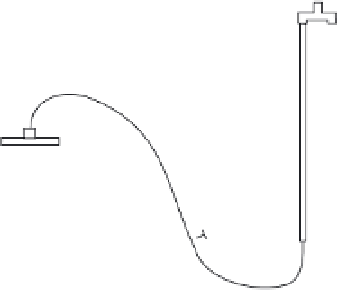Environmental Engineering Reference
In-Depth Information
4.3.2 Darcy method
The Darcy method is described for flow in the
unsaturated zone (
Chapter 5
) and saturated
zone (
Chapter 6
). Flow from or to a surface-wa-
ter body can also be estimated by this method
(LaBaugh
et al
.,
1995
; Wentz
et al
.,
1995
; LaBaugh
and Rosenberry,
2008
). Darcy's equation for ver-
tical flow can be written:
Manometer
board or
pressure
transducer
Valve or
clamp
Water
surface
q
=− ∂ ∂
KH z
s
/
(4.4)
where
q
is specific flux,
K
s
is vertical saturated
hydraulic conductivity, and ∂
H
/∂
z
is the verti-
cal hydraulic gradient. The gradient is deter-
mined from measurements of surface-water
stage and groundwater levels in nearby wells
or piezometers. The primary limitation in this
method, as discussed in previous sections, is
the large uncertainty associated with values
of hydraulic conductivity. One way to estimate
hydraulic conductivity in a streambed or lake
bed is to make simultaneous measurements of
flux (with a seepage meter) and hydraulic gra-
dient (Murdoch and Kelly,
2003
). A hydraulic
potentiomanometer (
Figure 4.5
; Winter
et al
.,
1988
; Rosenberry
et al
.,
2008
) is a simple device
designed specifically for determining verti-
cal head gradient by measuring the difference
between surface-water elevation and ground-
water level at some depth beneath the stream
channel. The potentiomanometer is most often
employed to identify areas of seepage into and
out of streams and lakes rather than to make
direct estimates of exchange. The Darcy method
can also be used in two or three dimensions if
flow is not strictly vertical. However, multidi-
mensional application requires many additional
points for measurement of groundwater levels.
Flow net analysis (
Section 6.3.3
), which is
based on the Darcy equation, also has been used
to estimate flow from and to surface-water bod-
ies (Cedergren,
1988
; Rosenberry
et al
.,
2008
).
Flow nets produce a recharge estimate that
is integrated over the study region, whereas
application of Equation (
4.4
) produces a point
estimate of recharge. Flow nets can help in
formulating conceptual models of a hydrologic
system, but they have been replaced by numeri-
cal groundwater flow models in most studies
(e.g. Trommer
et al
.,
2007
).
Filter
Probe
Streambed
Figure 4.5
Components of the hydraulic potentiomano-
meter (after Winter
et al
.,
1988
).
4.3.3 Analytical step-response function
Moench and Barlow (
2000
) and Barlow
et al
.
(
2000
) developed Laplace transform step
response functions to calculate changes in
groundwater levels, seepage to or from streams,
and bank storage that occurs in response to fluc-
tuations in stream stage. The stream is assumed
to fully penetrate the aquifer, and flow in the
aquifer is assumed to be horizontal. Required
data include stream stage and groundwater lev-
els at one or more points at different distances
from the stream. The method is an economical
alternative to a detailed numerical groundwa-
ter flow model; Barlow
et al
. (
2000
) showed that
results from the analytical approach are similar
to those obtained with a numerical model for a
site in eastern Iowa. The approach is particu-
larly useful for predicting recharge occurring
in response to sharp rises in stream stage, such
as occurs during floods (Ha
et al
.,
2008
).
4.4 Streamflow duration curves
Streamflow duration curves describe the rela-
tion between magnitude and frequency of occur-
rence of discharge in streams (
Figure 4.6
); they
are used in many types of hydrologic studies,


















